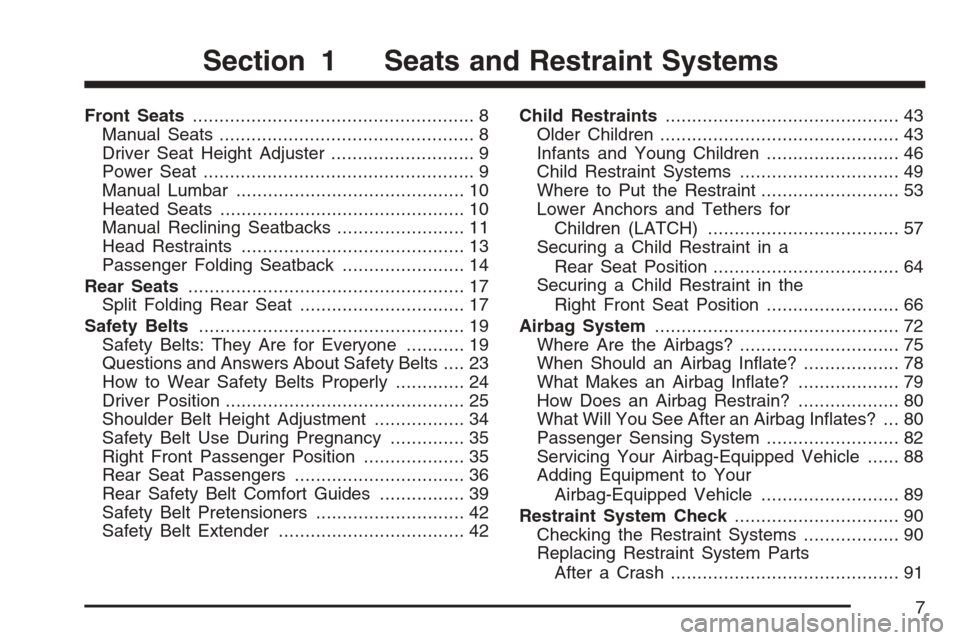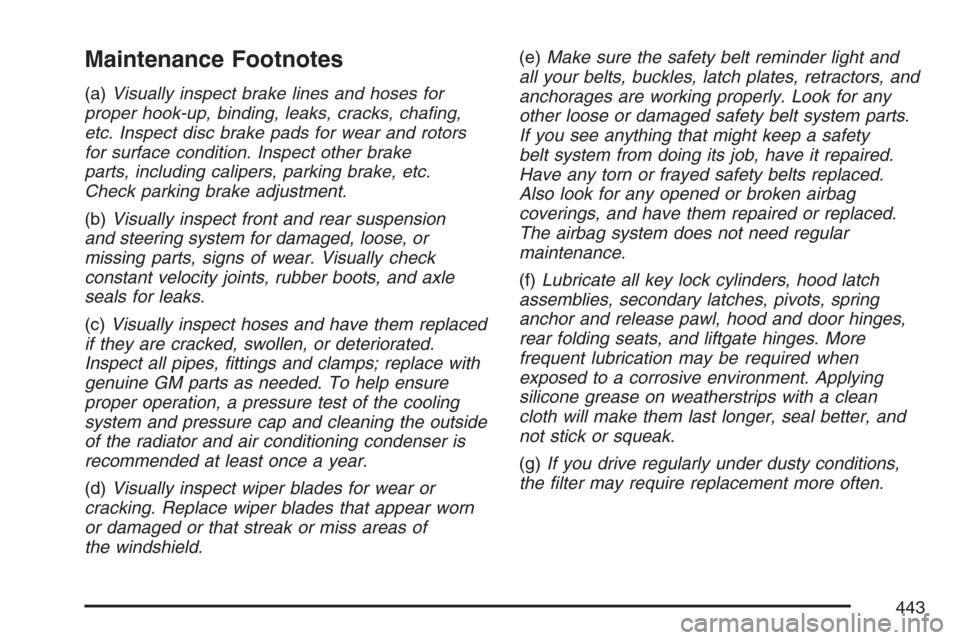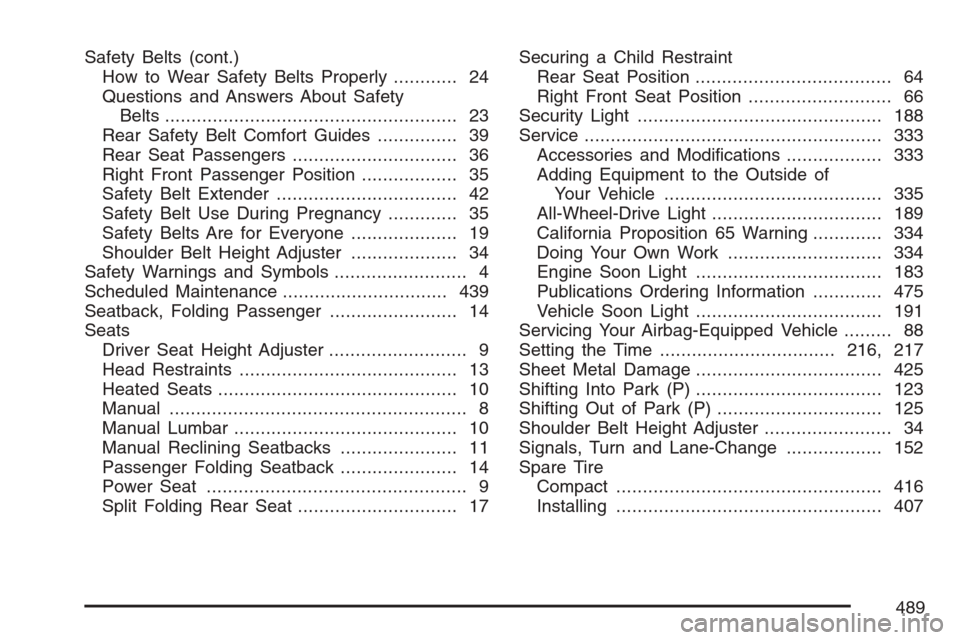2007 CHEVROLET EQUINOX fold seats
[x] Cancel search: fold seatsPage 7 of 492

Front Seats..................................................... 8
Manual Seats................................................ 8
Driver Seat Height Adjuster........................... 9
Power Seat................................................... 9
Manual Lumbar........................................... 10
Heated Seats.............................................. 10
Manual Reclining Seatbacks........................ 11
Head Restraints.......................................... 13
Passenger Folding Seatback....................... 14
Rear Seats.................................................... 17
Split Folding Rear Seat............................... 17
Safety Belts.................................................. 19
Safety Belts: They Are for Everyone........... 19
Questions and Answers About Safety Belts.... 23
How to Wear Safety Belts Properly............. 24
Driver Position............................................. 25
Shoulder Belt Height Adjustment................. 34
Safety Belt Use During Pregnancy.............. 35
Right Front Passenger Position................... 35
Rear Seat Passengers................................ 36
Rear Safety Belt Comfort Guides................ 39
Safety Belt Pretensioners............................ 42
Safety Belt Extender................................... 42Child Restraints............................................ 43
Older Children............................................. 43
Infants and Young Children......................... 46
Child Restraint Systems.............................. 49
Where to Put the Restraint.......................... 53
Lower Anchors and Tethers for
Children (LATCH).................................... 57
Securing a Child Restraint in a
Rear Seat Position................................... 64
Securing a Child Restraint in the
Right Front Seat Position......................... 66
Airbag System.............................................. 72
Where Are the Airbags?.............................. 75
When Should an Airbag In�ate?.................. 78
What Makes an Airbag In�ate?................... 79
How Does an Airbag Restrain?................... 80
What Will You See After an Airbag In�ates? ... 80
Passenger Sensing System......................... 82
Servicing Your Airbag-Equipped Vehicle...... 88
Adding Equipment to Your
Airbag-Equipped Vehicle.......................... 89
Restraint System Check............................... 90
Checking the Restraint Systems.................. 90
Replacing Restraint System Parts
After a Crash........................................... 91
Section 1 Seats and Restraint Systems
7
Page 17 of 492

Rear Seats
Split Folding Rear Seat
The rear split bench seatbacks have
three available positions — folded forward,
upright, or partially reclined. Both of the seatbacks
can be moved to any of the three positions
independent of the other seatback position.
The rear bench seat can also be moved forward
and rearward.
{CAUTION:
If the seatback is not locked, it could
move forward in a sudden stop or crash.
That could cause injury to the person
sitting there. Always push and pull on the
seatback to be sure it is locked.
{CAUTION:
A safety belt that is improperly routed,
not properly attached, or twisted will not
provide the protection needed in a crash.
The person wearing the belt could be
seriously injured. After raising the rear
seatback, always check to be sure that
the safety belts are properly routed and
attached, and are not twisted.
To fold the seatback down, do the following:
Notice:Folding a rear seat with the safety
belts still fastened may cause damage to
the seat or the safety belts. Always unbuckle
the safety belts and return them to their normal
stowed position before folding a rear seat.
1. Ensure all three of the safety belts are
unbuckled and the front seatbacks are
not reclined.
17
Page 320 of 492

If you put things inside your vehicle — like
suitcases, tools, packages, or anything
else — they will go as fast as the vehicle goes.
If you have to stop or turn quickly, or if there
is a crash, they will keep going.
{CAUTION:
Things you put inside your vehicle can
strike and injure people in a sudden stop
or turn, or in a crash.
Put things in the cargo area of your
vehicle. Try to spread the weight
evenly.
Never stack heavier things, like
suitcases, inside the vehicle so that
some of them are above the tops of
the seats.
Do not leave an unsecured child
restraint in your vehicle.
When you carry something inside the
vehicle, secure it whenever you can.
Do not leave a seat folded down
unless you need to.
Towing
Towing Your Vehicle
Consult your dealer or a professional towing
service if you need to have your disabled vehicle
towed. SeeRoadside Assistance Program on
page 462.
If you want to tow your vehicle behind another
vehicle for recreational purposes (such as behind
a motorhome), see “Recreational Vehicle
Towing” following.
Recreational Vehicle Towing
Recreational vehicle towing means towing your
vehicle behind another vehicle — such as behind
a motorhome. The two most common types of
recreational vehicle towing are known as “dinghy
towing” (towing your vehicle with all four wheels
on the ground) and “dolly towing” (towing
your vehicle with two wheels on the ground and
two wheels up on a device known as a “dolly”).
320
Page 443 of 492

Maintenance Footnotes
(a)Visually inspect brake lines and hoses for
proper hook-up, binding, leaks, cracks, cha�ng,
etc. Inspect disc brake pads for wear and rotors
for surface condition. Inspect other brake
parts, including calipers, parking brake, etc.
Check parking brake adjustment.
(b)Visually inspect front and rear suspension
and steering system for damaged, loose, or
missing parts, signs of wear. Visually check
constant velocity joints, rubber boots, and axle
seals for leaks.
(c)Visually inspect hoses and have them replaced
if they are cracked, swollen, or deteriorated.
Inspect all pipes, �ttings and clamps; replace with
genuine GM parts as needed. To help ensure
proper operation, a pressure test of the cooling
system and pressure cap and cleaning the outside
of the radiator and air conditioning condenser is
recommended at least once a year.
(d)Visually inspect wiper blades for wear or
cracking. Replace wiper blades that appear worn
or damaged or that streak or miss areas of
the windshield.(e)Make sure the safety belt reminder light and
all your belts, buckles, latch plates, retractors, and
anchorages are working properly. Look for any
other loose or damaged safety belt system parts.
If you see anything that might keep a safety
belt system from doing its job, have it repaired.
Have any torn or frayed safety belts replaced.
Also look for any opened or broken airbag
coverings, and have them repaired or replaced.
The airbag system does not need regular
maintenance.
(f)Lubricate all key lock cylinders, hood latch
assemblies, secondary latches, pivots, spring
anchor and release pawl, hood and door hinges,
rear folding seats, and liftgate hinges. More
frequent lubrication may be required when
exposed to a corrosive environment. Applying
silicone grease on weatherstrips with a clean
cloth will make them last longer, seal better, and
not stick or squeak.
(g)If you drive regularly under dusty conditions,
the �lter may require replacement more often.
443
Page 489 of 492

Safety Belts (cont.)
How to Wear Safety Belts Properly............ 24
Questions and Answers About Safety
Belts....................................................... 23
Rear Safety Belt Comfort Guides............... 39
Rear Seat Passengers............................... 36
Right Front Passenger Position.................. 35
Safety Belt Extender.................................. 42
Safety Belt Use During Pregnancy............. 35
Safety Belts Are for Everyone.................... 19
Shoulder Belt Height Adjuster.................... 34
Safety Warnings and Symbols......................... 4
Scheduled Maintenance............................... 439
Seatback, Folding Passenger........................ 14
Seats
Driver Seat Height Adjuster.......................... 9
Head Restraints......................................... 13
Heated Seats............................................. 10
Manual........................................................ 8
Manual Lumbar.......................................... 10
Manual Reclining Seatbacks...................... 11
Passenger Folding Seatback...................... 14
Power Seat................................................. 9
Split Folding Rear Seat.............................. 17Securing a Child Restraint
Rear Seat Position..................................... 64
Right Front Seat Position........................... 66
Security Light.............................................. 188
Service........................................................ 333
Accessories and Modi�cations.................. 333
Adding Equipment to the Outside of
Your Vehicle......................................... 335
All-Wheel-Drive Light................................ 189
California Proposition 65 Warning............. 334
Doing Your Own Work............................. 334
Engine Soon Light................................... 183
Publications Ordering Information............. 475
Vehicle Soon Light................................... 191
Servicing Your Airbag-Equipped Vehicle......... 88
Setting the Time.................................216, 217
Sheet Metal Damage................................... 425
Shifting Into Park (P)................................... 123
Shifting Out of Park (P)............................... 125
Shoulder Belt Height Adjuster........................ 34
Signals, Turn and Lane-Change.................. 152
Spare Tire
Compact.................................................. 416
Installing.................................................. 407
489